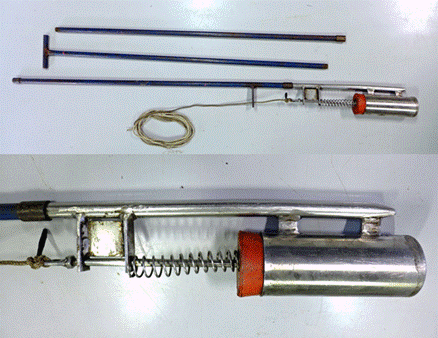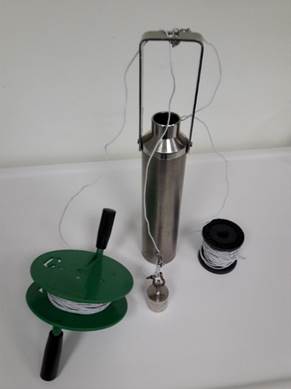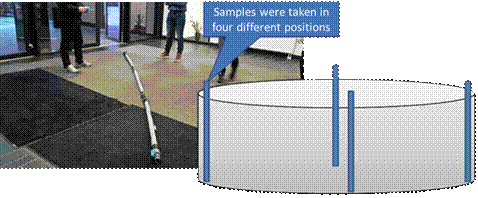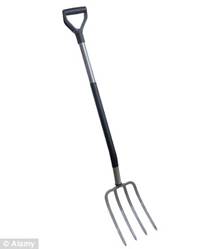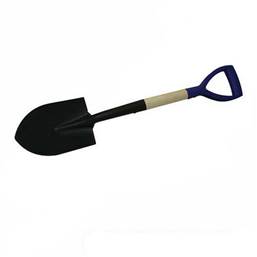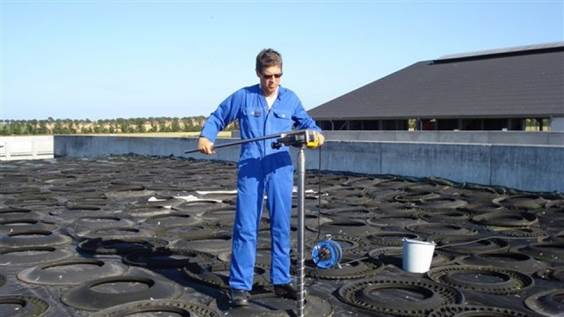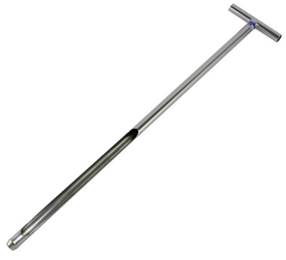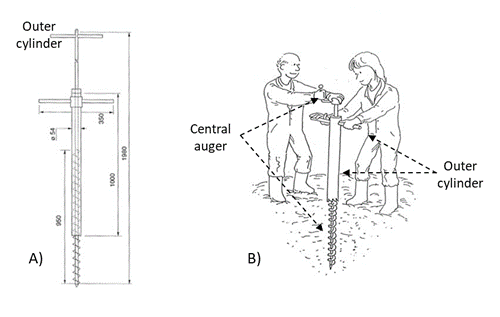Quick instructions
- Search through the whole table by using the "Search for..." field.
- Filter by a column with the filter function under each column header.
- Sort results by ▲ and ▼ buttons on each column. A click toggles between ascending and descending sorts.
- Download the results by clicking "Export to Excel". Note, "." is used as the decimal separator, which in some instances leads to results inappropriately be intepreted as dates. This depends on the localization settings of the computer where the file is opened.
Note. Mathematical operators are allowed. Use operators < and > to filter by a certain treshold. Combine with operator "and". E.g. filter phrase ">10 and <20" delivers the results between 10 and 20.
Information about the sampling methods
Publication by Interreg Baltic Sea Region project Manure Standards
Manure sampling instructions
Åsa Myrbeck, Lena Rodhe, Maarit Hellstedt,
Airi Kulmala, Johanna Laakso, Friederike Lehn,
Martin Nørregaard Hansen, Sari Luostarinen
These instructions for manure sampling were formulated within the project Manure Standards ( Advanced manure Standards for sustainable nutrient management and reduced emissions , Interreg Project No #R057) with the aim of harmonising sampling methods used within the Baltic Sea Region. The instructions are based on output from a previous project, Baltic Manure (Sindhöj et al., 2013), literature from within and outside the EU and feedback from tests of a first version on around 100 farms representing all nine countries bordering the Baltic Sea. These instructions have been circulated to project partners (see list in Appendix 2) and associate partners, including universities, research organisations, advisory services and other stakeholders in the Manure Standards project.
A central factor during the work was to assess the impact on the analysis results of sampling factors such as number of samples (or subsamples), sampling depth, handling of samples, time period between sampling and analysis etc.
Note that some countries, or even food companies, may have more rigid regulations on how sampling should be carried out (e.g. number of subsamples needed). In such cases, those special instructions should of course be followed in the first instance.
1.1. Manure definitions (KTBL, 2011)
The manure definitions used in this report are taken from the “Glossary of terms on livestock and manure management, 2011” issued by the Association for Technology and Structures in Agriculture (KTBL):
Slurry Manure (faeces and urine) produced by housed livestock, usually mixed with some bedding material and some water during management to give liquid manure with dry matter content in the range 1-10%.
Solid manure Manure from housed livestock that does not flow under gravity and cannot be pumped, but can be stacked in a heap. May include manure from cattle, pigs, poultry, horses, sheep, goats and rabbits.
Semi-solid manure Manure that cannot be pumped or stacked in a heap.
Deep litter Faeces or droppings and urine mixed with large amounts of bedding and accumulated over a certain time on the floor of animal houses.
Liquid fraction Varying degrees of separation of solids and liquid may occur during the management of manures, giving rise to liquid and solid fractions. The properties of these liquid fractions vary with the proportion of urine, faeces, bedding and water that they contain.
Solid fraction See “Liquid fraction” above. The solid fraction may include e.g. solids remaining following drainage or seepage of the liquid fraction from cattle bedded on straw on a sloping floor and solid fibrous material derived from mechanical separation of slurry.
Other terms, please see the Glossary: http://ramiran.uvlf.sk/doc11/RAMIRAN%20Glossary_2011.pdf
Reliable information on the nutrient content of manure is necessary in order to develop an effective and comprehensive nutrient management plan that maximises the effectiveness of crop use and growth and minimises nutrient runoff and pollution of adjacent waterways. Standard default values for manure properties are often used for nutrient balance planning when actual measurements are not available. Models can help calculate standard mass balance values for manure properties based on feeding practices, production intensity, standard housing systems and storage practices. However, the chemical and physical properties of manure also vary greatly depending on other manure management factors. Therefore, sampling and analysis of manure provides farm-specific information, which can improve utilisation of manure resources.
Manure is a heterogeneous product and appropriate sampling methodology is a prerequisite to obtaining representative data from manure analysis to be used e.g. as a basis for crop fertilisation. It is essential to define when, where and how manure samples are taken. Remember that the accuracy of manure analysis is only as good as the sample sent to the laboratory!
Results from manure analysis contain several sources of error, including errors from sampling, sample preparation and sample analysis. The largest source of error is sampling, as shown in Figure 1. The more subsamples taken from different spots in stored manure, the more accurate the final sample sent to the laboratory. However, as sampling is time-consuming, a balance must be struck between sampling accuracy and the time required. In general, the larger the storage, the more subsamples should be taken.
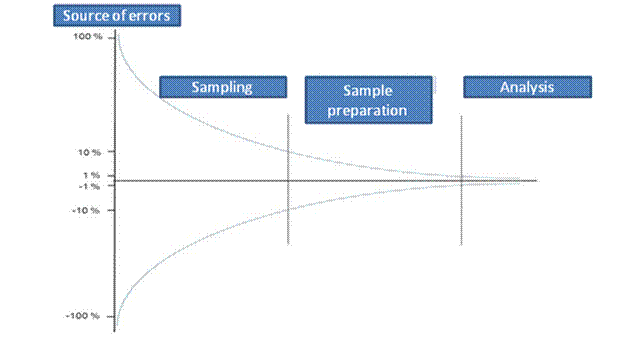
Figure 1. Contribution of different sources of error in sampling and analysing manure to the total error above and below the average. The greatest proportion of the error derives from the sampling procedure (Henkelmann, 2017).

|
The nutrient content in stored slurry is unevenly distributed with depth, due to stratification of organic material. The degree and pattern of distribution vary between different nutrients, as shown in Figure 2. Water-soluble nutrients such as ammonia-nitrogen (NH4-N) and potassium (K) are normally well distributed with depth, while phosphorus (P) and dry matter (DM) concentrations in particular tend to be high in the top and bottom layer, and lower in intermediate layers. For this reason, it is very important the contents of slurry tanks are well mixed before sampling. When slurry is well-mixed, only a few subsamples are needed.
Sampling of solid and deep litter manure requires a greater number of subsamples than sampling of slurry. The concentrations of nutrients and the dry matter content may vary widely between different spots in the pile, due to differences in manure source, time in storage and contact with the surrounding atmosphere (edge effects). A factor of high importance is the variation in plant-available ammonium nitrogen (NH4-N), which easily is lost as ammonia gas (NH3). Subsamples should be taken from different parts and depths in the pile. The number of subsamples recommended in section 4 of these instructions is a minimum and should be adjusted according to storage size and what is workable. Figure 3 shows how the accuracy of manure analysis is affected by the number of subsamples, using the example of two Swedish farms. On both farms, specialist equipment enabling sampling at different depths (slurry) and 1 m cross-sections (deep litter) was used. When less than five subsamples were taken, every added subsample increased the accuracy substantially, whereas when more than 10-15 subsamples were taken the improvement was only minor. With 10 subsamples, a confidence interval of approximately ±5-10 % of the mean was obtained for both slurry and deep litter manure storage (Figure 3). Previous studies have also found that 10 subsamples is a threshold number in this regard (Rodhe & Jonsson, 1999).

Figure 2. Concentration of nutrients (kg/ton, wet weight basis) and dry matter content (%) in an unmixed slurry tank holding slurry from slaughter pigs (Birkmose, 2003).
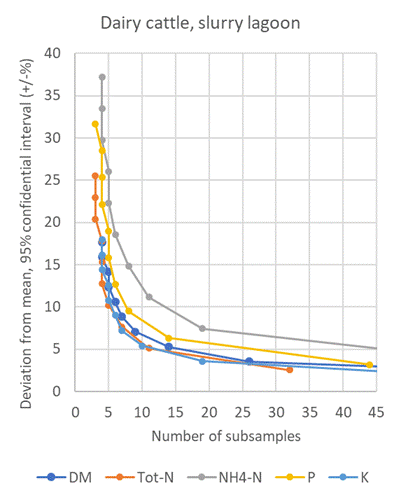
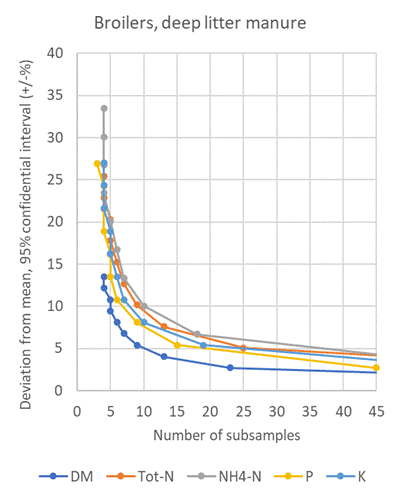
Figure 3. Effect of number of subsamples taken on the accuracy of manure analysis. Sampling on two Swedish farms of (left) dairy cattle slurry in a lagoon and (right) deep litter broiler manure in a heap. Deviation from the mean (±%) in 95% confidence intervals for different numbers of subsamples combined to make a final sample. On both farms, specialist equipment enabling sampling at different depths (slurry) and by 1 m cross-sections (deep litter) was used.
It may take from one to several weeks before the results of analyses are available from the laboratory, depending on the routines at the laboratory. Hence sampling on the same day as spreading will not supply data for immediate adjustment of fertiliser doses. For solid manure, it is therefore recommended to sample sufficiently far in advance. For slurry, if one extra mixing of the storage is not possible, analysis results can be used for calculating possible additional mineral fertiliser quantities. The results of manure analyses from previous years can be used to calculate the current manure application rate. Likewise, sampling from multiple spreader loads, which often gives very good data, especially for solid and deep litter manure, will not supply nutrient content information for immediate spreading.
Unmixed slurry tanks can be sampled in advance using specialist equipment enabling representative sampling of cross-sections (section 4.1 and Appendix 1).
(Based on Sindhöj et al., 2013)
Manure properties are affected by feeding practices, production intensity, manure handling and transport chains within the house, and the storage conditions. Disregarding possible manure processing techniques, a Danish manure model described by Poulsen et al. (2006) calculates standard values for manure at three points along the manure handling chain: ex-animal, ex-housing and ex-storage (Figure 4).
Ex-animal manure properties are dependent on feeding strategy, digestibility coefficient and production intensity. For sampling ex-animal, see Sindhöj et al. (2013). The manure sampling instructions in the following paragraphs are restricted to strategies for sampling ex-housing and ex-storage.
Ex-housing refers to manure leaving the house for storage, spreading or other form of disposal. Ex-housing manure properties are affected by housing climate, manure removal systems and other management factors, such as the use of bedding material, feed spills and wash water. Sampling strategies for ex-housing may need to include multiple sampling occasions if the climate factor is considered an issue. When manure is removed from the house in batches, for example slurry is emptied from a pumping pit at regular intervals, sampling manure ex-housing captures a snapshot of conditions between two removal periods.
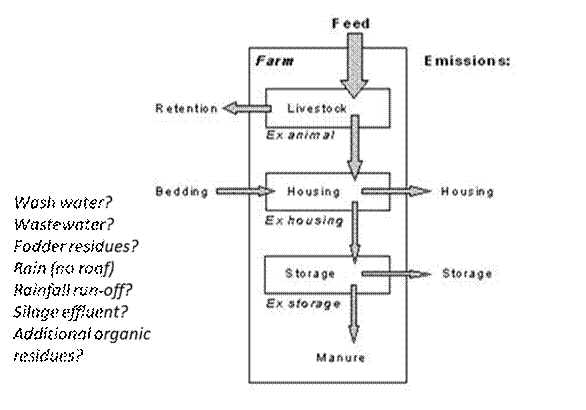
Figure 4. Conceptual model of animal production-related nutrient flows at farm level (modified from Poulsen et al., 2006). Inputs and outputs in italics can affect manure properties and its usability.
Ex-storage refers to manure leaving storage for field spreading or some other form of disposal. Sampling ex-storage shows properties of manure produced over a longer period, depending on storage capacity. However, sampling only at this stage will not provide information on impacts of key housing-related management practices or storage conditions and includes dilution with rain unless the manure is stored under a roof. Sampling strategies for ex-storage conditions will also depend on the storage capacity on the frm and how often it is emptied.
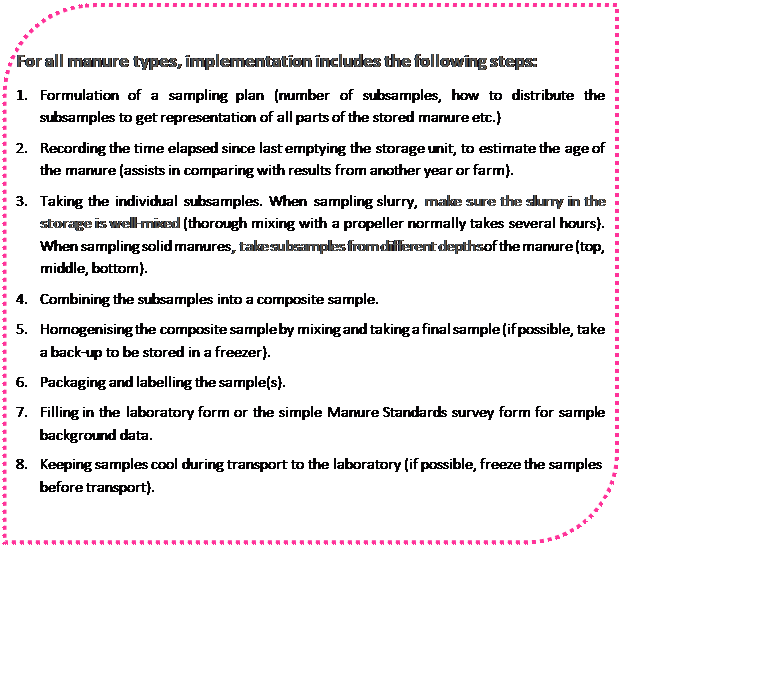
|
Having a representative manure sample is the basis for good fertiliser planning. The value of manure reported in analysis is highly dependent on the sampling technique. Examples of sampling devices that may be of use are shown in Appendix 1.
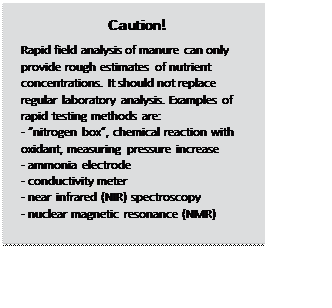 Plastic jars/containers should always be used for storing manure, as galvanised steel containers can interfere with the analysis results. Before sampling, check with the laboratory as to whether it has specific requirements on sample size, packaging and transporting. It may also provide containers.
Plastic jars/containers should always be used for storing manure, as galvanised steel containers can interfere with the analysis results. Before sampling, check with the laboratory as to whether it has specific requirements on sample size, packaging and transporting. It may also provide containers.
Do not fill containers to more than three-quarters, to provide air space for manure gases and to allow for expansion if the containers are frozen. Liquid manure in particular can build up pressure very quickly when warm.
Deciding where to sample, particularly for ex-housing, depends very much on the housing and manure handling system. Sampling ex-housing should occur where slurry from housing is collected, preferably from a pumping pit or buffer storage units, before transport to the storage facility. Sampling ex-storage can be done directly from the storage unit or from tank loads while spreading.
In order to get representative samples and accurate analysis results, it is very important that the contents of slurry pits or tanks are well-mixed before sampling, especially for total N and P, which will otherwise vary with depth due to stratification of the organic matter in slurry.
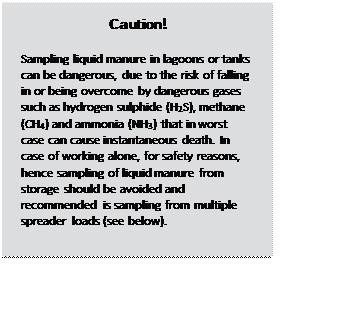 If the stored slurry is well mixed (characterised by a distinct circular flow around the whole tank), sampling with a bucket and fewer (2-3) subsamples are sufficient. If the slurry is less well mixed, more sophisticated equipment allowing collection of a sample from a specific depth below the surface (see examples in Appendix 1) and more subsamples are needed to get a representative sample.
If the stored slurry is well mixed (characterised by a distinct circular flow around the whole tank), sampling with a bucket and fewer (2-3) subsamples are sufficient. If the slurry is less well mixed, more sophisticated equipment allowing collection of a sample from a specific depth below the surface (see examples in Appendix 1) and more subsamples are needed to get a representative sample.
If slurry is stored in manure channels under slatted floors, sampling locations must be chosen carefully, and a larger number of subsamples combined to a composite sample. There is a very high risk of inaccurate data when the slurry batch is not well-mixed before sampling, and the analysis data obtained are not reliable.
When sampling from spreader loads, the sampling should be evenly distributed among the loads when emptying the storage unit. It may be necessary to sample up to 10 spreader loads, depending on the size of the storage unit. With a large storage tank, emptying may take many spreader tank loads over multiple days. Thus, the subsamples should be stored cooled down until mixing together into a composite sample.
Sampling from multiple spreader loads will not supply nutrient content information for immediate spreading, as the analysis takes at least a couple of days. However, analysis results can be used for calculating possible additional mineral fertiliser quantities. The results of manure analyses from previous years can be used to calculate the current manure application rate.
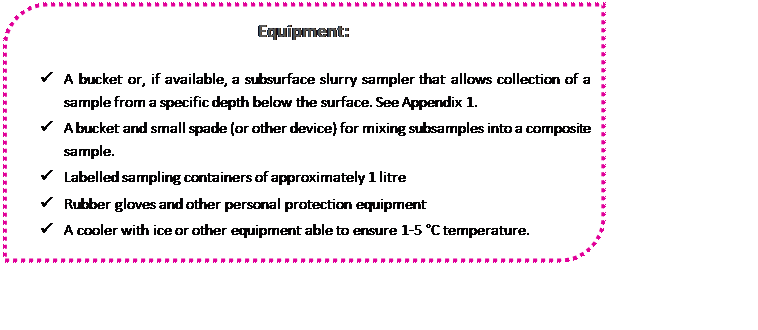
|
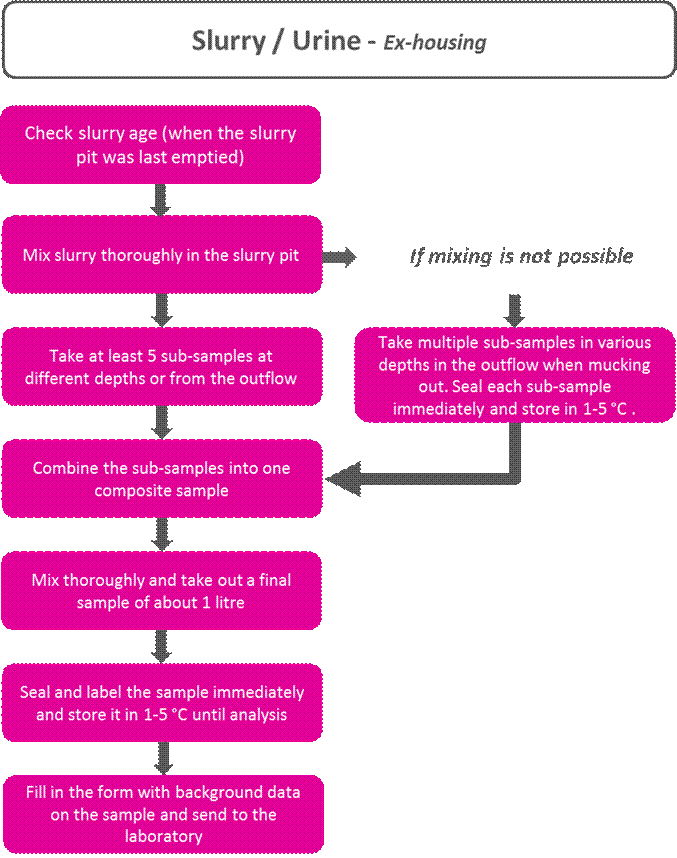
|
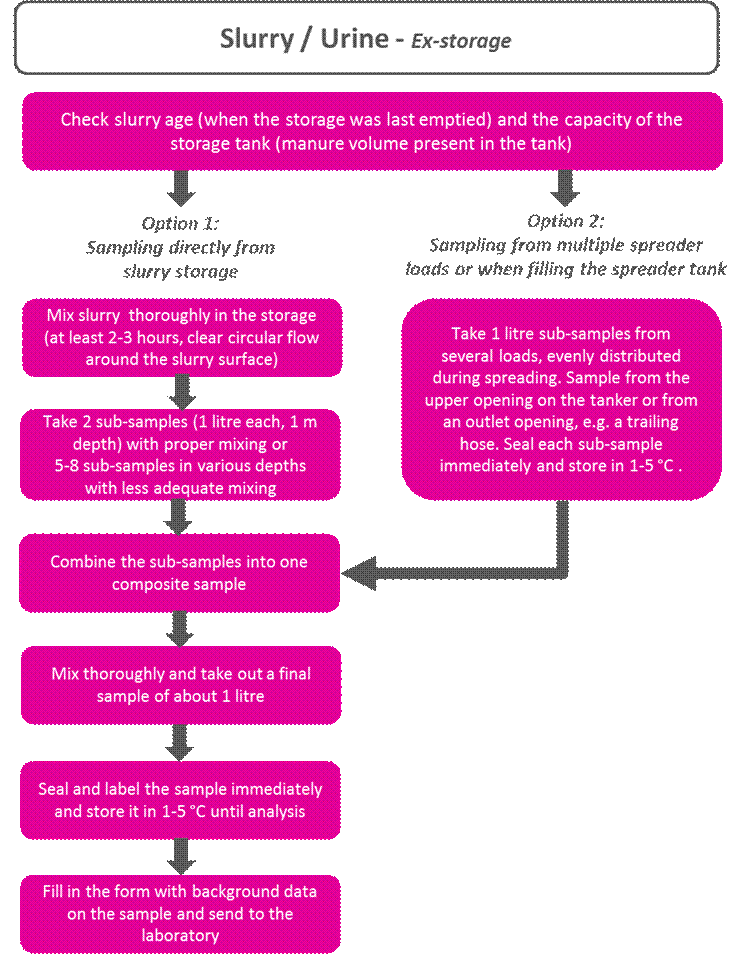
|
4.2. Solid, semi-solid and deep litter manure
Collecting a representative sample of solid, semi-solid or deep litter manure is more difficult than sampling slurry, due to the heterogeneous nature of such manure and the difficulties in mixing solids compared with mixing liquids. In general, a large number of subsamples is needed to obtain a representative final sample for analysis.
Sampling ex-housing should occur when manure is transported out of the house. Where the sampling takes place and how many subsamples are necessary to obtain a representative sample depend very much on the specific housing system. If the subsamples are taken e.g. once per day for a certain period of time, the subsamples should be stored cooled down until combining them into a composite sample. The subsamples should suffice for at least 2 liters of manure in the composite sample to ensure a representative final sample of 1 liter.
Sampling ex-storage can be done with two options: directly from the manure storage or from spreader loads during spreading or other form of disposal. Sampling directly from storage should occur as close to removal of manure from storage as possible, while still enabling laboratory results in time for fertiliser planning. An auger specifically designed for taking samples from solid manure piles or silage (see Appendix 1) will help in obtaining representative samples. Subsamples should be taken from different depths of the manure (top, middle and bottom). The subsamples should not represent the outer layer too much as it makes up only 10-20% of the total manure mass in the storage.
If sampling during emptying the storage (for spreading or other disposal), subsamples should be taken either from each spreader load or, in case of a large storage, from every second to fourth load to give an even sampling distribution over the entire bulk of the stored material. Sampling from multiple spreader loads will not supply nutrient content information for immediate spreading, as the analysis takes at least a couple of days. However, the analysis results can be used for calculating possible additional mineral fertiliser quantities. The results of manure analyses from previous years can be used to calculate the current manure application rate.
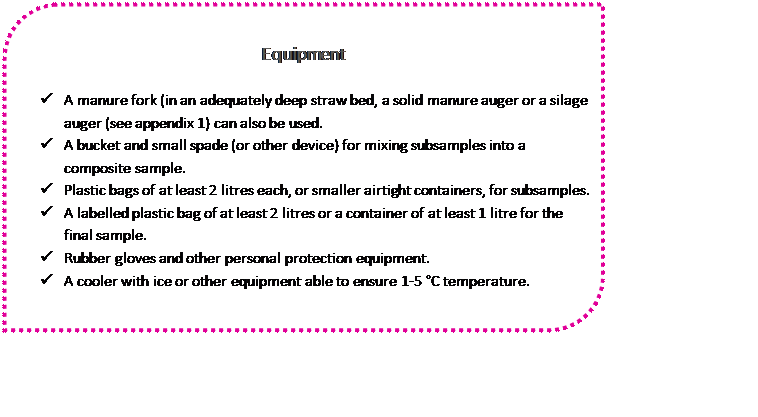

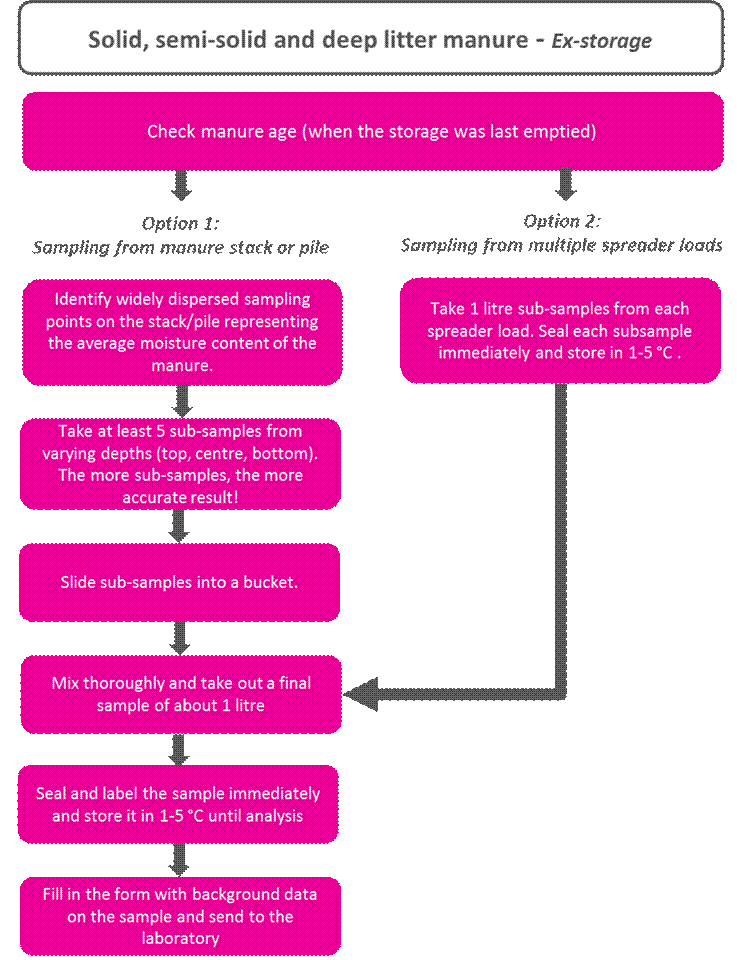
5. Handling and transport to laboratory
Manure samples should be tightly sealed to prevent leakage and double-bagged as an extra precaution. To ensure that samples sent for analysis are representative of the nutrient content in the original manure, proper precautions must be taken to avoid leakages, nutrient losses by volatilisation, moisture losses and nutrient transformations. The following approaches are recommended:
Make sure containers and plastic bags are tightly sealed, to avoid ammonia losses.
Keep samples cool in a refrigerator or by placing on ice. Warm temperatures promote nutrient conversion, which will change the nutrient content of the sample. The temperature should not be above 5 °C. Do not allow the samples to be in a warm environment, such as a car or the cabin of a truck, for longer than a few hours.
Freezing the samples before transport to the laboratory is recommended.
If a freezer is not available, transport samples to laboratory within a few days. Samples kept at room temperature should be analysed within 24 hours.
Send samples Monday-Wednesday, to ensure they can be processed by the laboratory before the weekend.
Clearly label all samples with permanent marker. At the very least, the label should state: farm name, type of manure, contact information, and date and time when the sample was collected.
Send samples together with a completed laboratory-specific order form. If not available, the Manure Standards survey form should be used.

*At several laboratories within the Baltic Sea Region, total C is not included in the standard analysis package for manure and may be excluded.
6. Understanding the manure test report
6.1. Wet basis or dry matter basis
The results of manure analysis can be reported in different ways, for example based on wet or dry matter weight (assembled basis or dry matter basis). If expressed on a dry weight basis (kg/kg DM), the values can be converted to a wet-weight basis as:
Nutrient content (%) on a wet weight basis = Nutrient content (%) on a dry weight basis x (% total solids/100)
The value obtained is then kg nutrient/kg wet weight slurry. Multiplying by 1000 will convert to kg/tonne slurry.
Slurry and urine are in most cases considered to have a volume weight of 1 kg per litre or one tonne per m3. The volume weight of solid, semi-solid and deep litter manure varies greatly depending e.g. on the type and amount of litter used.
The manure test results may be expressed as total elemental P or P 2O5. Conversion between the two can be made using:
P2O5 = Total P x 2.29
The manure test results may be expressed as total elemental K or K 2O. Conversion between the two can be made using:
K2O = Total K x 1.2
References/endnotes
Birkmose T. 2003. Natural sedimentation in slurry tanks holding pig slurry (Naturlig sedimentation i gyllebeholdere med svinegylle). Planteavlsorientering No. 7-465 (In Danish).
Henkelmann, G., 2017. Sampling from storages for slurry, fermenters and digestates as well as from storages for input materials and open silos, Probenahme aus Gülle-, Fermenter- und Gärrestbehältern, Einsatzstofflagern und offenen Silos. In: Biogas Forum Bayern Nr. III - 20/2017, Hrsg. ALB Bayern e.V., Online verfügbar unter: https://www.biogas-forum-bayern.de/media/files/0004/probenahme.pdf
KTBL, 2011. Glossary of terms on livestock and manure management, 2011. Association for Technology and Structures in Agriculture. Available at: http://ramiran.uvlf.sk/doc11/RAMIRAN%20Glossary_2011.pdf
Poulsen et al., 2006. Quantification of nitrogen and phosphorus in manure in the Danish normative system Hanne Damgaard Poulsen, Peter Lund, Jakob Sehested, Nicholas Hutchings and Sven G. SommerDIAS report 12th Ramiran International conference Technology for Recycling of Manure and Organic Residues in a Whole-Farm Perspective. Vol. II. 105-107.
Rodhe, L., Jonsson C., 1999. Provtagarutrustning för fastgödsel. [Sampler for solid manure]. Report no. 252. (In Swedish.) Swedish Institute of Agricultural and Environmental Engineering, Uppsala, Sweden.
Sindhöj, E. Kaasik, A., Kuligowski, K., Sipilä, I., Tamm, K., Tonderski, A. & Rodhe, L. 2013. Manure Properties on Case-Study Farms in the Baltic Sea Region. Report 417, Agriculture & Industry, JTI – Swedish Institute of Agricultural and Environmental Engineering. Uppsala, Sweden. ISSN-1401-4963.
Example of other references on manure sampling used within this work
Davis, J.G., Iversen, K.V., Vigil, M.F. 2002. Nutrient variability in manures: Implication for sampling and regional database creation. J of Soil and Water Conservation, 57 (6), 473-478.
Dou et al, 2001. Manure sampling for nutrient analysis: Variability and sampling efficacy. J. Environ. Qual. 30, 1432-1437.
Eurofins, 2013. Handboek monsterneming. Instructions for manure sampling. Instructie: MIN-2091-2092.
Peters, J. 2003. Recommended methods of manure analysis. Editor: John Peters. University of Wisconsin-extension, US.
Grøn Viden, 1994. Grøn Viden no.135. Statens planteavlsforsøk, Denmark.
KTBL. 2006. Gulle – Mengen genau ermitteln, Proben richtig ziehen (In German). Editors: Bohnenkemper, O., Steffens, G. Landwirtschaftskammer Niedersachen. Germany.
Roberts, S, Xin, H., Swestka, R, Yum, M, Bregendahl, K. 2016. Spatial variation of manure nutrients and manure sapling strategy in high-rise laying-hen. Poultry Science Association Inc. The journal of oxford Academic.
Zhu, J., Ndegwa, P.M., Zhang, Z. 2004. Manure sampling procedures and nutrient estimation by the hydrometer method for gestion pigs. Bioresource Technology, 92, 243-250.
Appendix 1. Examples of sampling devices for liquid and solid manure
|
Liquid manure |
|
|
|
Bucket method. Placing something heavy in the bucket or using a stick may help to press the bucket into the manure. |
|
|
A) Simple alternative with a cup on a broom handle. B) Tube, at least 5 cm in diameter, with a rubber ball tied on a string for closing at the desired depth. A broom handle for clean-out. (North Carolina State University, NC State Extension, U.S.) |
|
|
|
|
|
|
|
Sub-surface slurry sampler with a long pole, developed at former JTI (now RISE). Extension rods can be attached to the handle as needed. The volume collected is approximately 0.5 litres. Can also be used for other kinds of liquid manure (RISE, Sweden, PP3). |
|
|
Sampler that is thrown into the slurry/liquid manure for sampling at different depths (State Plant Protection Service, Latvia, PP12). |
|
|
A 4-m tube for sampling cross-sections in unmixed slurry storage tanks. It has been shown that four cross-sections per storage tank provide a satisfactory sample for analysis (SEGES, Denmark). |
|
Solid manure, semi-solid manure and deep litter |
|
|
|
|
|
|
Fork and spade |
|
|
A silage auger may be used for sampling solid manure or deep litter heaps. |
|
|
A soil sampler for sampling at different depths can be ordered from various companies. |
|
|
|
|
|
Solid manure and deep litter auger developed by former JTI (now RISE, PP3). A) Schematic diagram and dimensions of the sampler. B) The central auger is screwed into the manure pile and then the knife-edged outer cylinder is screwed down around the auger, thus cutting loose the auger core and allowing it to be removed. |
|
Sampling steps with a solid manure and deep litter auger: It is recommended that at least two people work together to take these samples. 1. One person holds the sampler steady by the handles attached to the outer corer, while the second person screws the central auger down into the manure pile until the desired depth is reached or the screw is fully deployed. The direction of screwing depends on how the auger is constructed. 2. One person then holds the central auger steady, while the other person screws the knife-edged outer cylinder around the central auger while pushing downwards, until the outer corer is all the way down. Drilling the corer down can be somewhat difficult and it is important that the unit remains steady to preserve sample integrity. 3. The entire sampler can now be lifted to remove the auger core. It may take two people to pull it up, depending on conditions. 4. The sampler is placed in the collection chute and the outer cylinder is pulled off the central auger. 5. The manure sample is removed from the central auger. |
|
Appendix 2. Project partners
|
Project Partner |
Country |
Organisation |
|
PP 1 |
FI |
Natural Resources Institute Finland (Luke) |
|
PP 2 |
PL |
Institute of Soil Science and Plant Cultivation |
|
PP 3 |
SE |
RISE - Research Institutes of Sweden |
|
PP 4 |
FI |
HELCOM |
|
PP 5 |
LT |
Lithuanian University of Health Sciences |
|
PP 6 |
EE |
Estonian University of Life Sciences |
|
PP 7 |
DE |
Julius-Kühn-Institute (JKI), Federal Research Centre for Cultivated Plants |
|
PP 8 |
FI |
Finnish Environment Institute SYKE |
|
PP 9 |
DK |
Aarhus University |
|
PP 10 |
DK |
Danish Agriculture & Food Council, SEGES |
|
PP 11 |
SE |
Swedish Board of Agriculture |
|
PP 12 |
LV |
State Plant Protection Service |
|
PP 13 |
EE |
Estonian Crop Research Institute |
|
PP 14 |
FI |
Central Union of Agricultural Producers and Forest Owners (MTK) |
|
PP 15 |
PL |
Agricultural Advisory Center in Brwinów |
|
PP 16 |
LV |
Farmers' Union Parliament |
|
PP 18 |
RU |
State budgetary vocational educational institution of the Pskov region "Pskov Agrotechnical College" |
|
PP 19 |
RU |
Interregional Public Organization "Society for Assistance of Sustainable Rural Development" |
|
PP 20 |
RU |
Federal State Budgetary Scientic Instition, Federal Scientific Agroengineering Center VIM IEEP-branch of FSBSI FSAC VIM |

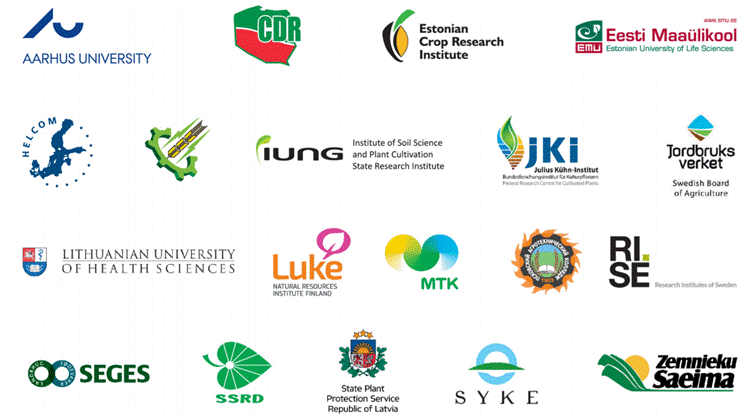
![]()



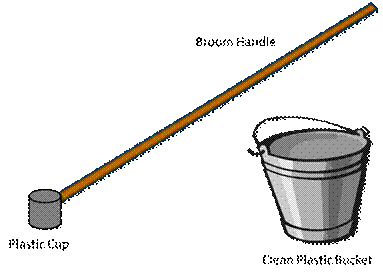 A)
A)
 B)
B)
